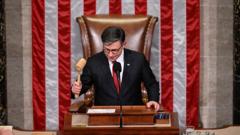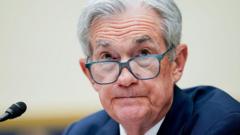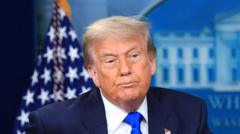As the US debt escalates to a staggering $37 trillion, apprehensions regarding the country's borrowing practices and financial future intensify. Trump's recently passed budget bill adds to this burden, prompting analysts to question the sustainability of US debt levels and the implications of potential default scenarios.
Concerns Loom as US Debt Reaches $37 Trillion Milestone

Concerns Loom as US Debt Reaches $37 Trillion Milestone
The US national debt surges past $37 trillion, raising alarms over sustainability and future repayment capacity amid Trump's new budget bill.
As Donald Trump lauded the passage of his controversial Big Beautiful Budget Bill through Congress, doubts surrounding the sustainability of US debt have come roaring back into focus. His budget plan is projected to increase the national debt by at least $3 trillion (£2.2 trillion), pushing the total debt to an eye-watering $37 trillion (£27 trillion). Critics of the plan, including past ally Elon Musk, have labeled it a "disgusting abomination."
This mountainous debt raises urgent questions about how much more the rest of the world is willing to loan to the United States. Signs of growing apprehension among investors have manifested in the dollar's weakened value and the higher interest rates now demanded for US loans. The need for borrowing stems from a persistent gap between government earnings and expenditure.
Since early 2023, the dollar has depreciated by about 10% against the British pound and 15% against the euro. Although borrowing costs have maintained a steady pattern overall, the intensified yield curve indicates a burgeoning skepticism regarding the viability of US borrowing in the long term. This concern arises even as US interest rates decline at a slower pace compared to those in the EU and the UK, which typically boosts dollar strength owing to higher available interest rates for investors.
Ray Dalio, founder of the world's largest hedge fund, has signaled that US borrowing is at a pivotal moment. He warns that, if not addressed promptly, the US may find itself spending upwards of $10 trillion annually on loans and interest payments. "The government's financial condition is at an inflection point," Dalio notes. "If this is not fixed soon, the debt will escalate to a level where it can only be managed through severe trauma.”
This "trauma" could manifest in several forms: significant cuts to government spending, steep tax hikes, or both. While Trump's new budget bill does propose some reductions in spending, it leans more towards tax cuts—pushing the trajectory in a precarious direction. Historically, in dire times, the US central bank has resorted to printing more money to buy up government debt, as seen after the 2008 financial crisis. However, such measures can inadvertently stoke inflation and exacerbate inequality among asset owners.
The most alarming potential outcome would be a sovereign default—the inability to meet debt obligations—which could destabilize the global financial landscape. The "full faith and credit of the US Treasury" underpins this system; thus, defaulting would have catastrophic consequences.
Currently, the threat of such a scenario remains low, although the undercurrent of concern is palpable. Mohamed El-Erian, an economist and former bond trader, conveyed that attempts to reduce dollar holdings are underway, emphasizing the dollar's heavy reliance despite its current overvaluation. “The dollar is like your cleanest dirty shirt—you have to keep wearing it,” he remarked.
Discussions around the future of the dollar and US government bonds have reached the highest echelons of power, with the Bank of England's governor recently acknowledging the importance of wary oversight of US debt levels.
Despite the staggering figure of $37 trillion—which equates to a million dollars saved every day over 100,000 years—it’s crucial to contextualize the debt as a percentage of national income. With the US economy generating approximately $25 trillion annually, its debt-to-income ratio is significant but remains lower than in countries like Japan or Italy. Underpinning this debt is a robust and innovative economy, suggesting that while the dollar's supremacy may be challenged, it is not on the verge of imminent collapse.





















